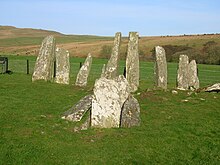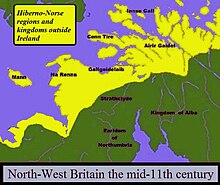Galloway
This article includes a list of general references, but it lacks sufficient corresponding inline citations. (November 2009) |

Galloway (
A native or inhabitant of Galloway is called a Gallovidian.[2][3] The region takes its name from the Gall-Gàidheil, or "stranger Gaels", a people of mixed Gaelic and Norse descent who seem to have settled here in the 10th century.[4]
Galloway is bounded by sea to the west and south, the Galloway Hills to the north, and the River Nith to the east; the border between Kirkcudbrightshire and Wigtownshire is marked by the River Cree. The definition has, however, fluctuated greatly in size over history.
A hardy breed of black, hornless cattle named Galloway cattle is native to the region, in addition to the more distinctive Belted Galloway or "Beltie".
Geography and landforms


Galloway comprises the part of Scotland lying southwards from the Southern Upland
The northern part of Galloway is exceedingly rugged and forms the largest remaining wilderness in Britain south of the Highlands. This area is known as the Galloway Hills.
Land use
Historically Galloway has been known both for
History
Galloway landmarks on Ptolemy's map

The 2nd century geographer
In the west, the city of Rerigonium (literally 'very royal place'), shown on
Early Galloway


The earliest recorded inhabitants were
Middle Ages

A Brythonic speaking kingdom dominated Galloway until the late 7th century when it was absorbed by the English kingdom of Bernicia.
English prevalence was supplanted by
If it had not been for
Alan died in 1234. He had three daughters and an illegitimate son Thomas. The "Community of Galloway" wanted Thomas as their "king". Alexander III of Scotland supported the daughters (or rather their husbands) and invaded Galloway. The Community of Galloway was defeated, and Galloway divided up between Alan's daughters, thus bringing Galloway's independent existence to an end.
Alan's eldest daughter,
There were a large number of new
Whithorn remained an important cultural centre, and all the
Modern history
Galwegian Gaelic seems to have lasted longer than Gaelic in other parts of Lowland Scotland, and Margaret McMurray (d. 1760) of Carrick (outside modern Galloway) appears to have been the last recorded speaker.
In the years after the
In modern times, Stranraer was a major ferry port, but the company have now moved to Cairnryan.
Galloway in literature
Galloway has been the setting of a number of novels, including Walter Scott's Guy Mannering. Other novels include the historical fiction trilogy by Liz Curtis Higgs, Thorn in My Heart, Fair is the Rose, and Whence Came a Prince.
Galloway is also the setting of several memoirs, including Devorgilla Days written by Wigtownshire author Kathleen Hart, an account of life in Wigtown, Scotland's national book town.
See also
References
- ^ Andy Eagle (27 February 2003). "The Online Scots Dictionary". Scots-online.org. Retrieved 18 June 2014.
- ^ "Gallovidian". Dictionary.com. n.d. Retrieved 27 September 2016.
- OED Online. n.d. Retrieved 18 September 2016.
- ^ Jennings, Andrew (1993). An Historical Study of the Gael and Norse in Western Scotland from c. 795 to c. 1000 (PhD thesis). The University of Edinburgh. pp. 138–146.
- ^ "Those green hills that are the haunt of angels". The Herald. 13 May 1995.
- ^ Ptolemy 140 Ptolemy, Bk. II, Ch. 2. Trans.[who?] Albion island of Britannia - First Map of Europe
- ^ Learmonth, William (1920). Kirkcudbrightshire and Wigtownshire. Cambridge: Cambridge University Press. p. 1. Retrieved 27 November 2022.
- Brooke, D: Wild Men and Holy Places. Edinburgh: Canongate Press, 1994 ISBN 0-86241-479-2
- Oram, Richard, The Lordship of Galloway. University of St Andrews, 1988
- Ptolemy (c. 140), Thayer, Bill (ed.), Geographia, LacusCurtius website at the University of Chicago, retrieved 26 April 2008
External links
- Galloway Dialect at Scots Language Centre
